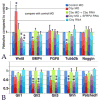Chibby functions in Xenopus ciliary assembly, embryonic development, and the regulation of gene expression
- PMID: 25220153
- PMCID: PMC4539557
- DOI: 10.1016/j.ydbio.2014.09.008
Chibby functions in Xenopus ciliary assembly, embryonic development, and the regulation of gene expression
Abstract
Wnt signaling and ciliogenesis are core features of embryonic development in a range of metazoans. Chibby (Cby), a basal-body associated protein, regulates β-catenin-mediated Wnt signaling in the mouse but not Drosophila. Here we present an analysis of Cby's embryonic expression and morphant phenotypes in Xenopus laevis. Cby RNA is supplied maternally, negatively regulated by Snail2 but not Twist1, preferentially expressed in the neuroectoderm, and regulates β-catenin-mediated gene expression. Reducing Cby levels reduced the density of multiciliated cells, the number of basal bodies per multiciliated cell, and the numbers of neural tube primary cilia; it also led to abnormal development of the neural crest, central nervous system, and pronephros, all defects that were rescued by a Cby-GFP chimera. Reduction of Cby led to an increase in Wnt8a and decreases in Gli2, Gli3, and Shh RNA levels. Many, but not all, morphant phenotypes were significantly reversed by the Wnt inhibitor SFRP2. These observations extend our understanding of Cby's role in mediating the network of interactions between ciliogenesis, signaling systems and tissue patterning.
Keywords: Chibby; Cilia; Hedgehog; Neural crest; Neural plate; Pronephros; Snail2; Wnt signaling; Xenopus laevis.
Copyright © 2014 Elsevier Inc. All rights reserved.
Conflict of interest statement
Figures









Similar articles
-
Identifying domains of EFHC1 involved in ciliary localization, ciliogenesis, and the regulation of Wnt signaling.Dev Biol. 2016 Mar 15;411(2):257-265. doi: 10.1016/j.ydbio.2016.01.004. Epub 2016 Jan 16. Dev Biol. 2016. PMID: 26783883 Free PMC article.
-
Role of Sp5 as an essential early regulator of neural crest specification in xenopus.Dev Dyn. 2013 Dec;242(12):1382-94. doi: 10.1002/dvdy.24034. Epub 2013 Sep 30. Dev Dyn. 2013. PMID: 24038420
-
Drosophila chibby is required for basal body formation and ciliogenesis but not for Wg signaling.J Cell Biol. 2012 Apr 16;197(2):313-25. doi: 10.1083/jcb.201109148. J Cell Biol. 2012. PMID: 22508513 Free PMC article.
-
Xenopus to the rescue: A model to validate and characterize candidate ciliopathy genes.Genesis. 2021 Feb;59(1-2):e23414. doi: 10.1002/dvg.23414. Epub 2021 Feb 12. Genesis. 2021. PMID: 33576572 Review.
-
Cilia and development.Curr Opin Genet Dev. 2019 Jun;56:15-21. doi: 10.1016/j.gde.2019.05.002. Epub 2019 Jun 12. Curr Opin Genet Dev. 2019. PMID: 31201996 Review.
Cited by
-
Identifying domains of EFHC1 involved in ciliary localization, ciliogenesis, and the regulation of Wnt signaling.Dev Biol. 2016 Mar 15;411(2):257-265. doi: 10.1016/j.ydbio.2016.01.004. Epub 2016 Jan 16. Dev Biol. 2016. PMID: 26783883 Free PMC article.
-
Nuclear roles for cilia-associated proteins.Cilia. 2017 May 25;6:8. doi: 10.1186/s13630-017-0052-x. eCollection 2017. Cilia. 2017. PMID: 28560031 Free PMC article. Review.
-
Developmentally regulated GTP-binding protein 1 modulates ciliogenesis via an interaction with Dishevelled.J Cell Biol. 2019 Aug 5;218(8):2659-2676. doi: 10.1083/jcb.201811147. Epub 2019 Jul 3. J Cell Biol. 2019. PMID: 31270137 Free PMC article.
-
Polarized Sonic Hedgehog Protein Localization and a Shift in the Expression of Region-Specific Molecules Is Associated With the Secondary Palate Development in the Veiled Chameleon.Front Cell Dev Biol. 2020 Jul 28;8:572. doi: 10.3389/fcell.2020.00572. eCollection 2020. Front Cell Dev Biol. 2020. PMID: 32850780 Free PMC article.
-
Chibby functions to preserve normal ciliary morphology through the regulation of intraflagellar transport in airway ciliated cells.Cell Cycle. 2015;14(19):3163-72. doi: 10.1080/15384101.2015.1080396. Cell Cycle. 2015. PMID: 26266958 Free PMC article.
References
-
- Ariizumi T, Takahashi S, Chan TC, Ito Y, Michiue T, Asashima M. Isolation and differentiation of Xenopus animal cap cells. Curr Protoc Stem Cell Biol. 2009;Chapter 1(Unit 1D):5. - PubMed
-
- Bradley L, Sun B, Collins-Racie L, LaVallie E, McCoy J, Sive H. Different activities of the frizzled-related proteins frzb2 and sizzled2 during Xenopus anteroposterior patterning. Dev Biol. 2000;227(1):118–32. - PubMed
-
- Carl TF, Dufton C, Hanken J, Klymkowsky MW. Inhibition of Neural Crest Migration in Xenopus Using Antisense Slug RNA. Dev Biol. 1999;213(1):101–115. - PubMed
Publication types
MeSH terms
Substances
Grants and funding
LinkOut - more resources
Full Text Sources
Other Literature Sources
Research Materials

